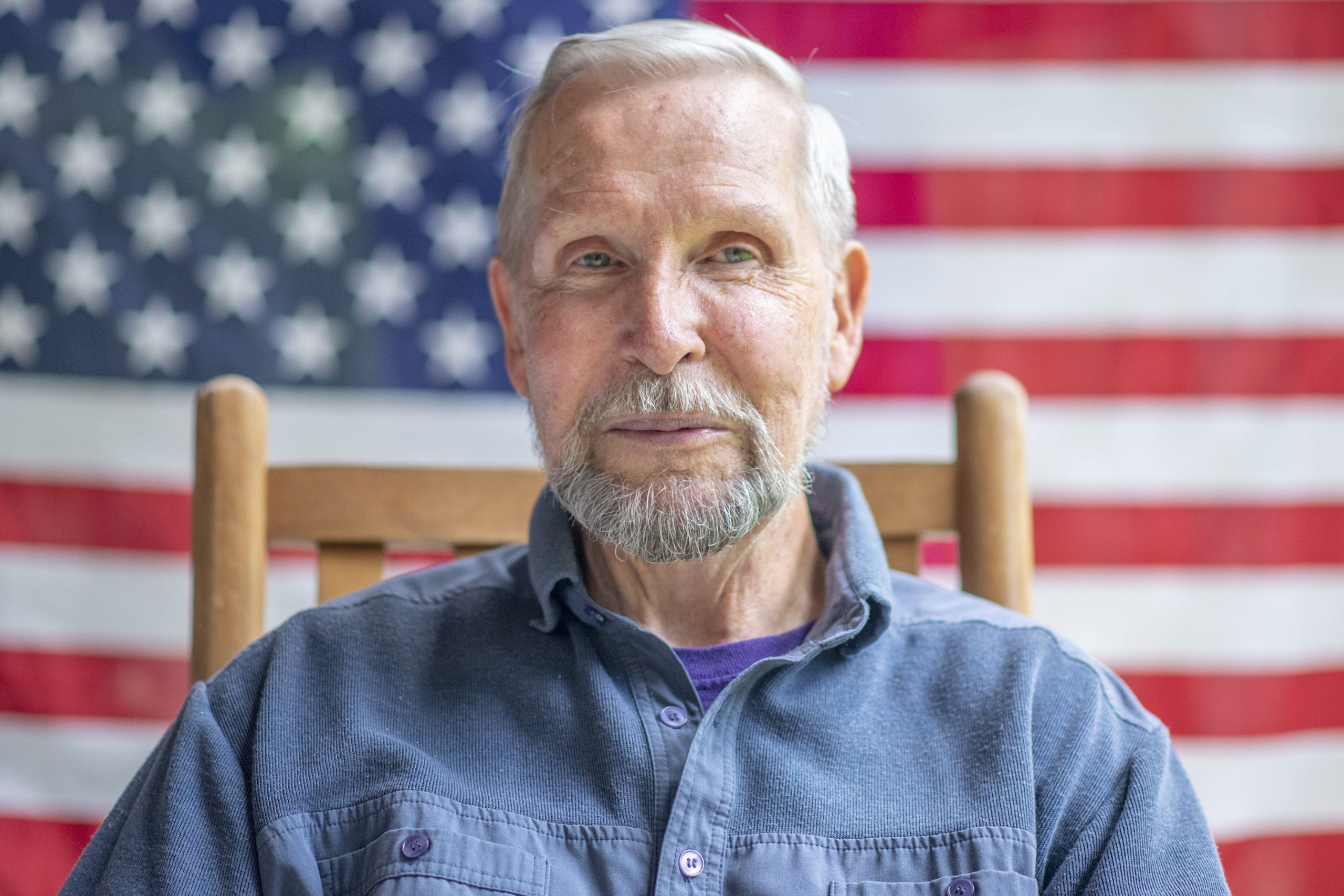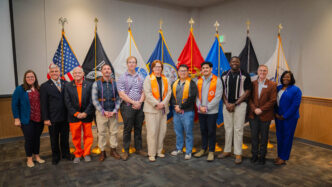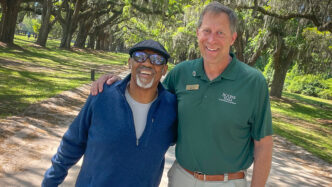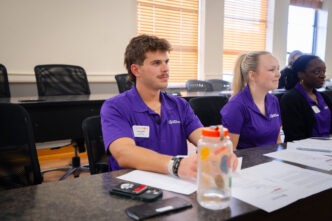
U.S. Air Force Capt. William R. Austin II and his aircraft commander, Maj. Ivan D. Appleby, had out-maneuvered certain death hundreds of times before they got hit. A fighter pilot with the storied “Triple Nickle” 555th Tactical Fighter Squadron, Austin had flown 80 combat missions over North Vietnam in the powerful F-4 Phantom II, despite the enemy’s relentless attempts to make each a one-way trip. By the time he landed his 80th mission in the fall of 1967, he’d earned a Silver Star, two Distinguished Flying Crosses, and 10 Air Medals.
It was easy for him, cutting through the sky faster than sound: His radar warning system would pick up an enemy surface-to-air missile (SAM) approaching and, blessed with better-than 20/10 eyesight, he’d watch through the cockpit window until he could see it streaking towards them. The tiniest glint of sunlight off metal was all he needed. Once his eyes locked on it, he could time the next move.
On his signal, his aircraft commander would brake hard to one side, forcing the missile to attempt a turn demanding more “G’s” than it could stand. The Russian-made SAMs used by the North Vietnamese Army (NVA) were designed to take down heavy, non-maneuverable B-52’s, so they would break themselves apart and explode trying to follow the nimble F-4.
Austin took off on his 81st mission October 7, 1967, with Kansas native Appleby in the front seat. It was a highly unusual photo reconnaissance escort mission involving four F-4’s, two armed and two unarmed, in an attempt to trick the enemy into thinking they were an easy target. During the mission, they would be the only friendly aircraft in the skies over Vietnam, with permission to destroy any other aircraft they saw. They expected the NVA would send MiG’s to intercept, which the armed F-4’s would shoot down.
As usual, there would be the seemingly endless supply of anti-aircraft artillery on the ground to deal with. Austin and Appleby had dodged and destroyed 13 SAMs the day before, and 19 the day before that.
On this day, the enemy got lucky.
Flying about 25 miles southwest of the city of Hoi Binh, Austin’s radar picked up a missile coming from behind their plane to the left 7 o’clock, but when he turned to spot it he couldn’t find it. His radar continued to track a missile, closing in on them from behind, and still he couldn’t find it. At the last second, Appleby spotted the missile bearing down on them from the front right 2 o’clock, 180 degrees from where Austin’s radar warning system was showing.
“I’d never missed a missile once my system told me which way to look,” said Austin, in his warm southern drawl, during an interview at his lakefront home in Seneca, South Carolina. “The only way I can explain it is; they had worked on the radar warning system in my plane the day before. I’m assuming what happened is they hooked the antennas up backwards when they put the box back in.”
Appleby threw the F-4 into a nose-dive, avoiding a direct hit.
“We were doing about Mach 1.2,” said Austin. “Ap jammed the stick against the firewall and the airplane violently pitched tail up, nose down, and boom! The missile blew up right under us.”
The explosion set the left afterburner on fire, instantly filling the cockpit with smoke so thick that Austin couldn’t see his instrument panel.
Appleby dumped the cabin pressure and shut the left engine down, which cleared out the smoke. The two pilots fought to keep the severely damaged F4 in the sky, but it was limping.
“We were doing okay, except our utility hydraulic system was on zero, and one of our primary hydraulic systems was winding down,” said Austin. “It didn’t take but a few seconds and it was gone. After a minute or so we noticed the other one was coming down too. We flew about 60 or 70 miles before we lost all control of the airplane.”
They steered over the mountains south of Hanoi, trying to stay above the clouds, but the plane started rolling to the right. The two men stepped as hard as they could on the left rudder controls, but F-4’s were not designed to be flown manually. The rudder didn’t budge. The ground was 12,000 feet below and coming up fast.
“Time to get out,” Appleby said.
Austin reached for the ejector handle on his seat.
“See you on the ground,” he said, and pulled.
FROM THE FARMS TO THE SKY
William “Bill” Austin II was born in Greenville, South Carolina in 1937 to Nell Blakely and William Renwick Austin. William Sr. ran a dairy farm, almost single-handedly, and as a youth Austin would watch his father get up at 3 a.m. to tend to and milk his 125 cattle, process the milk, and deliver it himself; usually not sitting down for supper until 10 at night, only to start all over again five hours later.
In his teenage years Austin and his cousins worked on his uncle’s dairy farm; gathering grain, cutting corn, and making silage. The work was physically demanding (they would routinely throw around 300-pound sacks of grain) so much so that the high school football coach exempted them from two-a-day practices.

Laughed Austin: “He said, ‘You guys are in good enough shape, you don’t need the extra practice!’”
His parents recognized the high intelligence and athletic ability in their boy and encouraged him in all pursuits. Their support instilled a confidence in him that would serve him well throughout his life. He graduated from Simpsonville High School and applied to Clemson and Duke. He was accepted to both, but chose Clemson, to follow in his father and cousins’ footsteps. Since the draft was mandatory at the time, he also had another choice to make – Army, Air Force, Navy or Marines.
“When I was about 13 I saw the movie ‘The Bridges of Toko Ri.’ It’s about a Navy pilot and it set me on fire,” he recalled. “I was ready to go to the Navy, but then I thought about landing on a little ship and living in bunks and that didn’t appeal to me at all.”
At 6’3” life on a ship would have been uncomfortable at best.
“I decided to go to the Air Force,” he said, grinning. “It was a good choice.”
After a debaucherous freshman year, he got serious and his academic performance at Clemson skyrocketed. That caught the attention of the Air Force, which had a rapidly growing need for new officers. In his junior year he was given special permission to drop out of the ROTC program as long as he committed to go to the new Air Force Officer Training School as soon as he graduated. He received his degree in mechanical engineering in 1959 and, after turning down several navigation training assignments, headed to Lackland Air Force Base near San Antonio, Texas hoping to become a pilot.

The Air Force moved right away to capitalize on Austin’s capabilities, sending him to Electronic Warfare Officers School (EWOS). He served in the 55th Strategic Reconnaissance Wing from 1961 – 1965, then got accepted to pilot training and reported to Laughlin Air Force Base in Del Rio, Texas in June, 1965.
He earned his pilot wings in 1966 and was sent to Vietnam. He began flying in F-4s as a pilot systems operator, a crucial job that Austin mastered, quickly placing him in high demand. He earned a reputation for a laser focus and his strength, which meant the tall farm boy was almost always put into the lead aircraft of a formation. When an especially tricky or important mission came up, they would call Capt. Austin.
That’s how he came to be flying as Maj. Appleby’s systems operator, a pile of awards for valor stacked up in his official Air Force file back home, when the lucky missile crippled their plane and forced him to pull the ejection handle.
Austin describes the next few moments as a slow-motion dream.
“The canopy blew off, the seat fired, and the world slowed down. I was looking at the instrument panel in front of me and it was going about this speed,” he said, raising his hands to his eyes and then dropping them slowly into his lap. “I said ‘I wonder if I’m ever going to get out of this cockpit I can’t believe how slow this is.’ That’s just how fast my mind was working.”
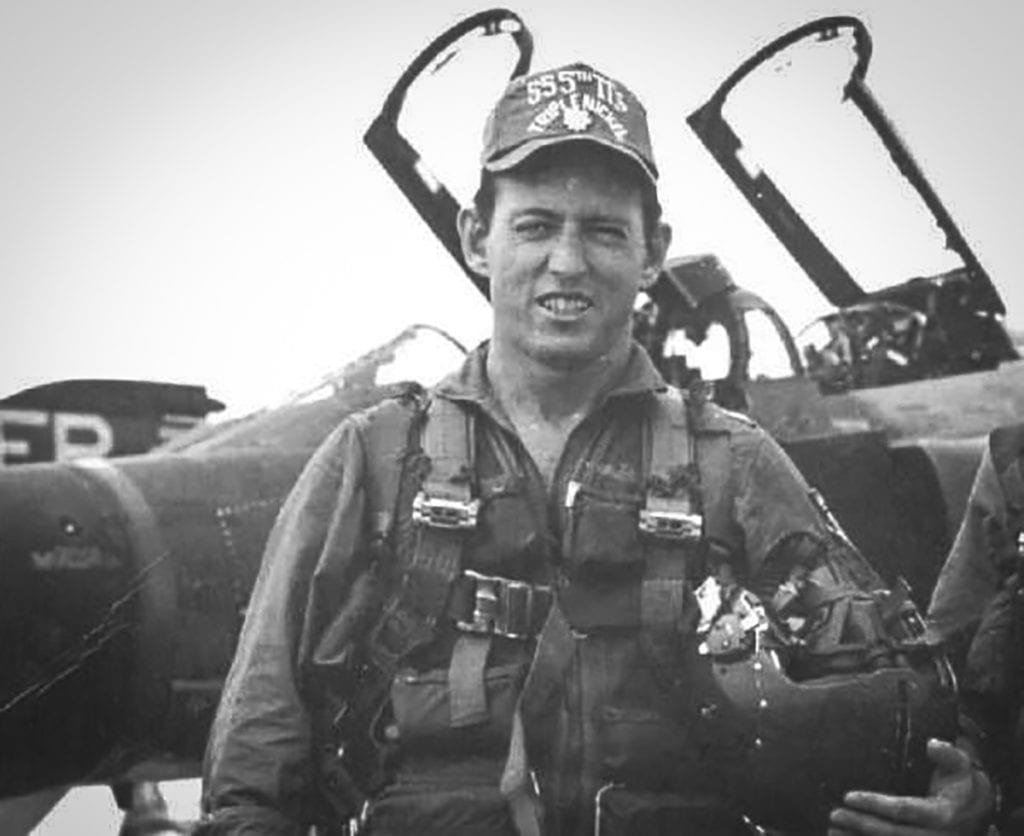
Austin blasted free and felt the jerk of his parachute opening as the mighty warplane fell away into the clouds. As he floated out from under the white layer, he saw where the F-4 had crashed into the valley below, causing a fireball as long and wide as a football field.
It would be many years before he found out his ejection caused the tail to break off the already weakened aircraft, essentially splitting it in half. Appleby, whose quick thinking and selfless leadership had saved Austin’s life, never had a chance. He was 37 and left behind his wife, Shirley, and three children; Jay, Bonnie and Andrea, aged 11, 10, and 8 at the time. His remains were not found and verified until 1995, and he was buried in Arlington National Cemetery that December.
GROUNDED
Austin drifted over a banana-shaped valley filled with people who had been working in rice paddies, all looking up at him now. He pulled down on the parachute lines and steered himself towards the bordering jungle, which would give him a better chance of hiding and evading.
He swooped toward “the biggest tree in the woods” and crashed through, arms crossed over his chest to protect himself. He bounced off one branch after another, breaking his hip and two vertebrae in his back. Miraculously his parachute didn’t catch on a limb – it came all the way through with him, and he hit the ground standing up.
He scrambled to pull his parachute out of the tree, wrapped it around his helmet, and sank them in a water-filled stump hole. His life raft had also come down through the tree, fully inflated. He pulled it down and was stabbing it with his knife when the first Vietnamese showed up.
“I pulled out my .38. I had three boxes of ammunition with me, and I didn’t plan on giving up,” said Austin. He knew the first round in his chamber was a tracer, so he fired it over the man’s head as a warning, hoping his wingman would see if from above and register his location.
He didn’t know he’d already been surrounded by 16 enemy militia men, 15 with AK-47’s and one with a bamboo rifle. When he fired the tracer, they unloaded on him.
“All hell broke loose then, boy, bullets flying everywhere,” said Austin. “They were shooting for everything they were worth. I still wasn’t going to give up. There was a big tree to my right. I figured I could jump behind the trunk and use it as a shield to get into the jungle behind me. I was dang certain that a long-legged guy like me, scared to death, could run a lot faster than a bunch of short-legged Vietnamese.”
As he dove for the tree, he smacked into the ground like he’d been tackled. His right foot wouldn’t budge. Confused, he pulled and tugged but it wouldn’t move. The rock he’d landed on had a crack through it, and the force of his landing had driven his boot two inches down into it. It was like being caught in a trap.
“I tried everything I could. By this time, I could feel bullets going by my head,” said Austin. “I put my hands up, and the shooting intensified. I realized I still had my 38 in my hand, so I threw it down. I got up and tried again and the same thing happened. They were still shooting like mad.”
A bullet hit his shin and spun him around, wrenching the ankle of his trapped leg and throwing him to the ground. He uttered a simple prayer as he lay there, “God, if this is it let’s get it over quick.”
The next thing he remembers, he was standing and raising the white parachute-shaped sea anchor attached to his life raft, and the shooting had stopped.
The men approached, pried his foot out of the rock and marveled at his size when he stood up. He towered over them. They put three nooses around his neck and led him away like a horse.
They didn’t know they were caging a Tiger.
PRISONER OF WAR
Austin was taken to a one-room bamboo school house with a thatched roof and tied to the supporting post in the center. His mind was still racing, looking for any way to escape. It was looking worse by the minute. Outside, word was spreading that a giant American pilot had been captured. A most valuable prize. Austin heard a crowd gathering.
They brought him out and showed him off to ooos and ahhs from the small gathering of villagers. Some female soldiers posed for pictures with him. Then his keepers marched him through the night to a one-building military outpost, where they took his flight suit and gave him peasant clothes to wear. Again, he could hear a crowd gathering, but this time the shouts were not curious or friendly. They were fierce. Austin knew from previous missions that several downed U.S. pilots had made it to the ground safely, and even radioed back their coordinates, only to be killed by angry locals.
This time when they brought him out, the crowd stretched as far as he could see.

“I’m guessing anywhere from 750 to 1,000 people were out there,” he recalls. “They were all shaking their fists and yelling, nostrils were flaring. They’d been whipped into a frenzy. To be quite frank I was scared. I thought they were going to tear me apart.”
An old man tried to sick a large dog on Austin from behind, but the huge beast rushed right past the POW and jumped on a man in the front row of the crowd, biting and tearing at his clothes. Austin laughed, and the crowd laughed, and it immediately diffused the situation. The dog, who he had petted and fed while locked in the building, had saved his life for the time being.
Next, Austin was taken to the maximum-security prison in Hanoi, where he was interrogated and tortured for five straight days, 24 hours a day.
“They said I was a war criminal, that they had not signed the Geneva Convention, and that I’d be treated as such,” he explained.
They tortured him mercilessly, implementing different forms of cruelty – like hanging him by his ankles and beating him with strips of rubber – to force him to talk. They beat him until the nerves were dead in his hands and lower legs, which swelled to the size of watermelons.
When they couldn’t get any information out of him, they tied his elbows together behind his back, ripping the muscles in his chest, and bound his arms together from elbow to wrist. Then they crossed his legs and folded him over until his Adam’s apple was against his ankles. He calls that technique “the pretzel” and they would leave him like that for hours, then ask if he was ready to talk. He’d tell them yes so they would untie him and he could get blood flow back into his arms and legs. When he’d only give them his name, rank and serial number they would force him back into the pretzel. He repeated this until they stopped untying him.
Throughout this nightmare, he remained surprisingly calm.
“I sort of slipped into a euphoria and thought, I think I can tough this out,” he said. “Once they tore all the muscles out of my chest, the pain was tolerable let’s put it that way. I did a little self-hypnosis. I remember thinking to myself, if this is all they’re going to do to me they’re not ever going to get me to talk.”
At one point, as he was tied into the pretzel, he lost consciousness and was awoken by a blinding white light. This was an interesting torture technique, he thought. All he had to do was close his eyes to avoid it.
“But then I realized my eyes were already closed,” he said. “And my nose was still down against the floor. There wasn’t any way they had a bright light between my eyes and the floor – it was being generated internally. That’s when I got scared.”
After all the enemy’s attempts, his own mind turning against him is what finally generated true fear.
He called out to the guards that he was ready to talk, but after tricking them so many times they didn’t believe him. He told them he had a wife and kids, the first new information he’d given, so, after five days of continuous torture, they untied him and moved him to the infamous Heartbreak Hotel, where he was shackled and put into solitary confinement and grilled for another 17 days.
He continued to stall and mislead his captors throughout the ordeal, pointing at random places on a map and telling them they were targets, and making up details about American equipment and strategies.
At one point they tied him to a desk and told him to write down everything he knew. He held up his hands, which were broken and twisted from their torture.
“I told them, your men fixed it so I can’t write. My hands don’t work,” he said. He suggested maybe he could write with a pen in his mouth.
The guard placed a pen on the desk and left the room. After scrawling a few words holding the pen in his teeth, it ran out of ink. When the guard came back he refilled the pen and left again. Austin wrote a couple more words, unscrewed the pen using the backs of his hands and poured the ink into a toilet bucket. He repeated this until his captors became frustrated and stopped asking him to write.
Three men he calls “the good cop, the bad cop, and the worst cop” took turns interrogating and torturing him. Each had different levels of cruelty and fluency in English. They beat him until he couldn’t stand or even sit up. He lost hope he’d ever have use of his hands or feet again, and it seemed inevitable that he was going to die there.
“I will say that the thought of suicide passed through my head,” he said. “I didn’t care whether I lived or died, but I decided I would take one of them with me at least. The guy that had physically put me in those torture positions was the same guy that was turning the keys in my lock every day. He was the worst. He tortured me and everybody before me. They called him ‘Young Lion’. He was a little bigger and stronger than the rest of them. I decided I would kill him.”
Austin knew that if he managed to get his hands on Young Lion, whether he was successful or not, it would most likely be his last action on Earth – but he figured it would be worth it.
“Even though my hands didn’t work, I knew if he got close enough I could get him in the crook of my arm and . . . I didn’t have any doubt I could break his neck.”
Austin never got his chance to pounce. Young Lion, perhaps sensing danger, suddenly became very wary of the Tiger. He stopped coming into Austin’s cell, and started putting Austin’s daily ration of food on the floor and sliding it into the room with his foot.
His first glimmer of hope came when he was moved from the Heartbreak Hotel to a prison compound called the Zoo Annex. There, he shared a room with two Navy pilots and Maj. Tom Sterling, an F-105 Thunderchief systems operator who had been shot down and captured six months before him. Sterling had broken both femurs in his supersonic ejection and a German doctor had put pins in it, there in Hanoi, and he was regaining the use of his limbs.
“His feet were like mine, they were drooped down. We called it foot drop. They just hung like a piece of meat,” said Austin. “His feet were healing. When he saw my hands, he said, ‘That’s nerve damage. It will heal.’ That was the first hope I had.”
Austin did heal, but slowly. The torturing became less frequent, and he regained the use of his left hand after about three months, the use of his right after six, and it took 18 months to get his feet back. After that he would run in place for an hour, do 500 push-ups, 500 sit-ups, and 500 leg-ups every morning as the days, weeks, months and years went by.
In the end, he spent 1,986 days as a prisoner of the NVA.
OPERATION HOMECOMING
Back in the states, Austin’s wife Myrtle, together with wives of other POW’s, had been on a tireless crusade for their release that brought her all the way to the Oval Office.
President Nixon consulted with Myrtle and Beverly Mims, wife of another Clemson Air Force ROTC graduate who was shot down, Capt. George Mims Jr., before launching Operation Linebacker, the most intense bombing campaign against the NVA since the start of the war. He told them he believed the campaign could end the war, but there was a chance their husbands could be killed in the air strikes. Both women told Nixon to go through with it, because it’s what their husbands would want. (Mims was listed as KIA in April, 1973. His body has not been recovered.)
Operation Linebacker commenced in May 1972. Huge swaths of North Vietnamese cities were leveled. The devastation helped convince Hanoi to return to the bargaining table.
Austin and 207 other POW’s, to be used as valuable bargaining chips, had been transported to a remote prison near the border of China. In January 1973 they were transported back to Hanoi, where they joined other POWs at the former French consulate building they called the Plantation. On January 25 they were led to the courtyard and put in military formation, with Air Force Brig. Gen. John P. Flynn, the highest-ranking POW in Vietnam, in command, and told they would be freed.
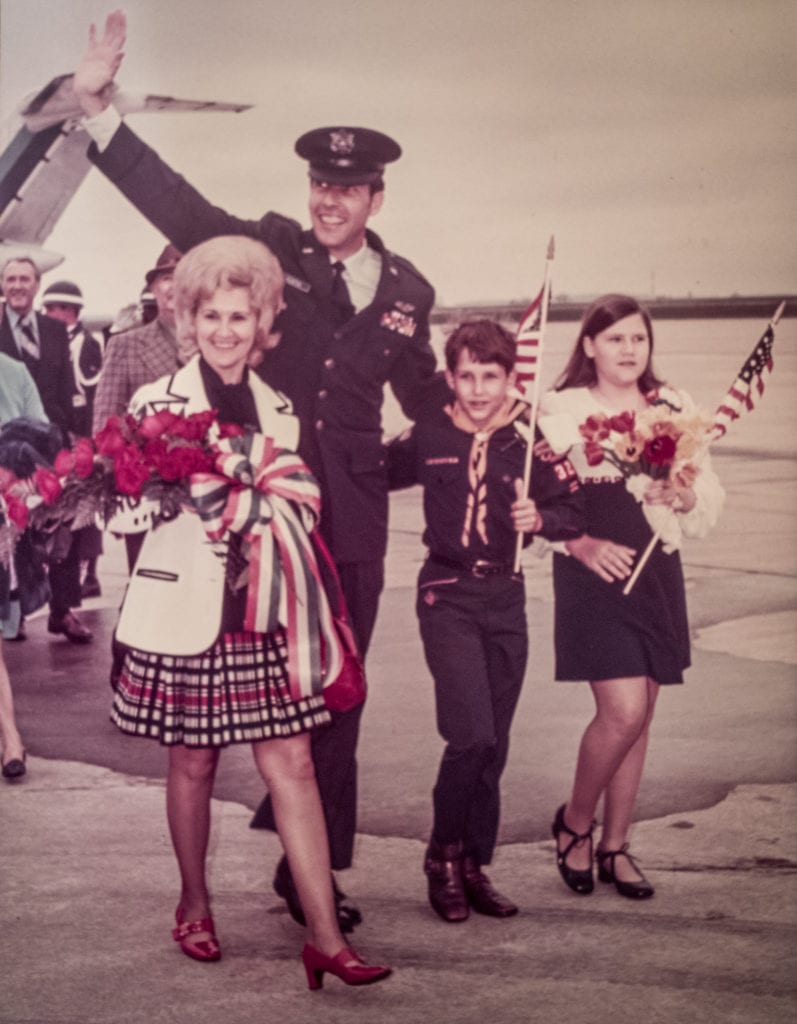
The Americans, joyous inside, kept their military demeanor and stood still as stone.
“Don’t you understand?” their captors shouted. “You’re being freed!”
Not one of the POWs made a sound. They had agreed beforehand that they wouldn’t give the NVA the satisfaction.
“When I got back to my room, I buried my face in a blanket and started screaming for joy,” said Austin.
On Feb. 12, 1973 three American C-141 transport planes flew into Hanoi to bring the 591war heroes home. The event was broadcast on news stations from coast-to-coast. Austin was put on the third flight home, on March 14, 1973.
“I stood by the window in the back of the airplane and watched until we got over the ocean,” said Austin. “Only then did I allow myself to think we were going to make it.”
They were flown to the Philippines, where a huge crowd greeted them, on to Hawaii and an even bigger crowd (“At two in the morning!”), and finally to Maxwell Air Force Base in Alabama where their families awaited. It was there that Austin finally learned Appleby had gone down with their plane.
After two weeks of medical check-ups and debriefings, Austin was flown home to Greenville, where a crowd of more than 4,000 people greeted him at the airport. Waiting on his doorstep was a large bouquet of flowers, sent to Myrtle from President Nixon.

50 YEARS
For consistently resisting the enemy’s demands through the entirety of his imprisonment by calling upon his deepest inner strengths, Austin received his second Silver Star.
He remained a full mission-ready pilot after his return and served 15 more years in the Air Force. For his final assignment he returned to his beloved Clemson and served as its Air Force ROTC detachment commander from 1985 until his retirement in 1988.
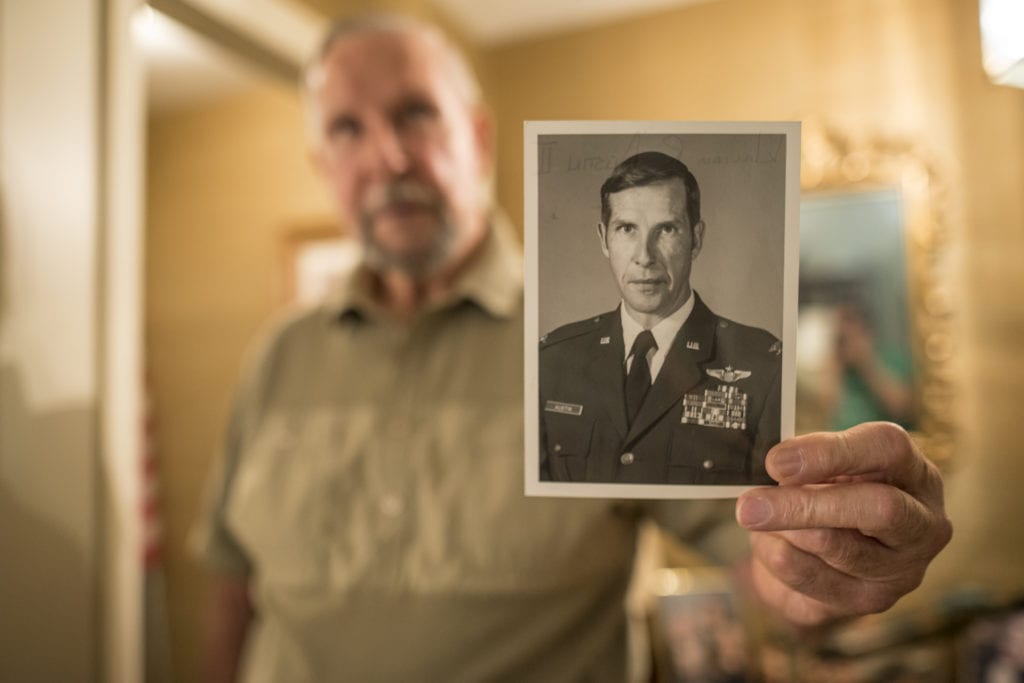
Today, at 80, Austin lives a quiet life not far from the Clemson campus, splitting his time between the farm he grew up on in Greenville and a house in Seneca. He lives with many scars, including broken vertebrae in his neck where he was “taught to bow correctly” with the butt of a rifle. Despite his wounds, he still towers over people, figurately and literally, having become a legend around Clemson and the greater Upstate area, and still standing every inch of his 6’3”.
“Colonel Austin is an amazing role model for me as the current detachment commander and as an Air Force officer,” said Col. Keith W. Balts, commander of Clemson’s Air Force ROTC program. “His selfless service as a POW in the face of so much adversity is beyond inspiring, as was his desire to continue serving long after he was released. On a personal level, I’ve thoroughly enjoyed getting to know him this past year and know he continues to inspire every cadet and cadre member he meets.”
When Austin talks about the horrors he endured, it’s with precision rather than emotion, revealing the cool focus that made him a great fighter pilot. He is not a man that feels sorry for himself or seeks sympathy. In his words his son, daughter and wife are more deserving.
“In my opinion the families suffered more than we did,” he said. “Yeah, we had physical torture, but the mental anguish of what they went through was probably worse. We knew what was happening to us; they could only imagine.”
When asked if he has forgiven his captors, he does not hesitate.
“When I was in the cell for 17 days by myself at the very beginning and didn’t think I’d ever walk or have the use of my hands again, I hated them. No doubt about it,” he stated matter-of-factly. “But I started to pray one time for God to get me out of there, and then I thought ‘Who the hell do you think you are?’.”
Austin figured if God didn’t help Jesus off the cross, why should he expect God to break his shackles and throw open the prison gates?
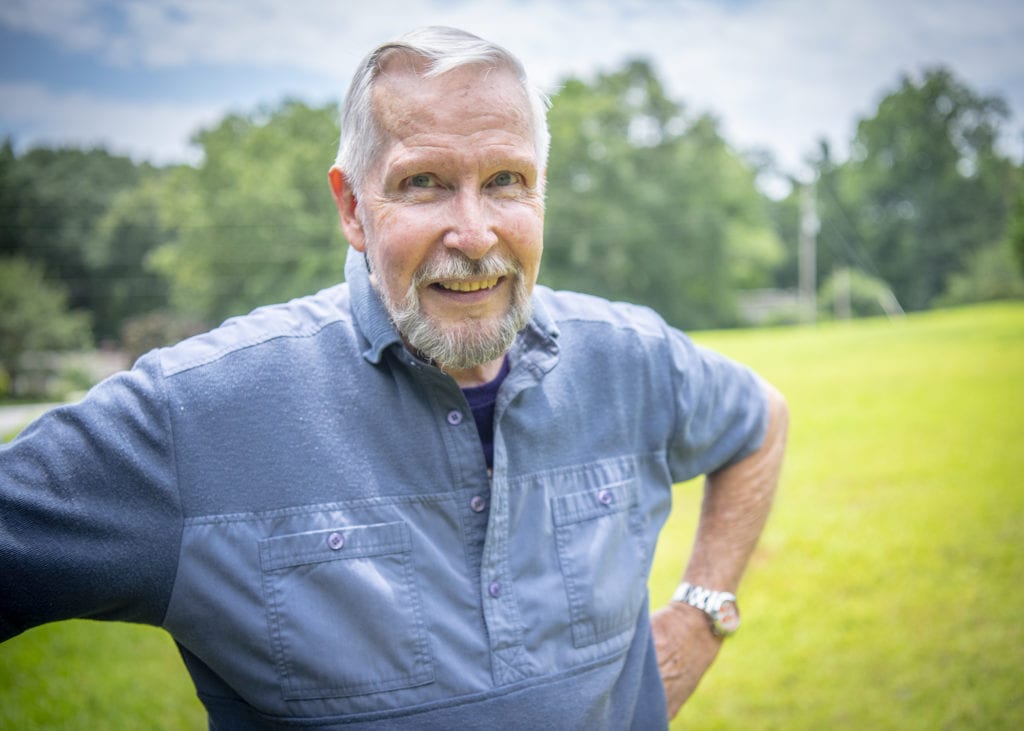
He remembers that, as he lay in his cell dwelling on it, a sermon he’d witnessed when he was 15 slipped into his mind. The preacher described love and hate as two sides of a circle.
“He said they’re almost the same emotion, because they take the same energy from you,” recalled Austin. “If you love somebody you give of yourself to them, same when you hate somebody. That sort of ended the hatred. I couldn’t allow myself to hate these people, because I’d just be giving of myself to them.”
He says confidence – in God, his wife, his country, and in himself – kept him alive.
“I credit my upbringing, my family, and my friends at Clemson for getting me through,” he said. “I’ve been fortunate to always be confident. My parents told me early on I could be anything I wanted to be, and I never questioned that. That confidence in myself helped me through. I said if anybody can survive this, I can.”
The story of his and his fellow POWs’ survival now inspires service members across the spectrum of America’s armed forces, from hopeful recruits to seasoned leaders.
“Colonel Austin is truly an American hero, with an incredible story of resilience, perseverance and sheer courage,” said General Jay Raymond, commander of Air Force Space Command, and the highest-ranking graduate in the history of Clemson’s ROTC program. “He exemplifies the meaning of service before self, and carries on a proud legacy of Clemson Tigers who have valiantly served our great nation.”
After Operation Homecoming, the U.S. still listed 1,350 Americans as prisoners of war or missing in action, most of them pilots who had been shot down. Austin considers himself very lucky not to be on that list.
“I thought I was dead, but it’s been 50 years since I was captured,” he said. “I’m just thankful to be alive.”

